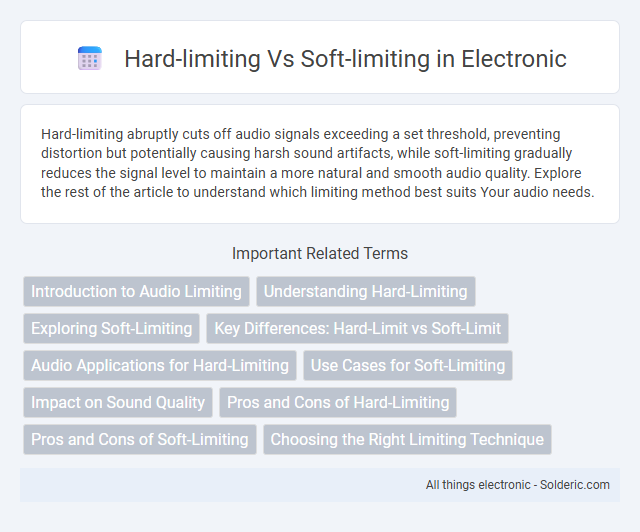Hard-limiting abruptly cuts off audio signals exceeding a set threshold, preventing distortion but potentially causing harsh sound artifacts, while soft-limiting gradually reduces the signal level to maintain a more natural and smooth audio quality. Explore the rest of the article to understand which limiting method best suits Your audio needs.
Comparison Table
| Feature | Hard-Limiting | Soft-Limiting |
|---|---|---|
| Definition | Clipping signal amplitudes abruptly at a fixed threshold. | Gradually compressing signal amplitudes near the threshold. |
| Signal Distortion | High, causes sharp waveform clipping and harmonics. | Low, smooth transition reduces distortion. |
| Usage | Simple amplitude limiting in digital and analog circuits. | Audio processing, dynamic range compression. |
| Effect on Signal | Produces hard clipping artifacts. | Preserves signal integrity with mild compression. |
| Complexity | Low, easy to implement. | Higher, requires adaptive control. |
| Example Applications | Signal clipping in limiters, simple protection circuits. | Audio compressors, dynamic range controllers. |
Introduction to Audio Limiting
Audio limiting controls the dynamic range by capping audio signal peaks to prevent distortion and clipping. Hard-limiting enforces a strict threshold, resulting in abrupt peak attenuation, while soft-limiting applies gradual gain reduction for a more natural sound. Choosing between hard and soft limiting depends on the desired output, balancing between maximum loudness and preserving audio quality.
Understanding Hard-Limiting
Hard-limiting is a signal processing technique where input signals are strictly clipped once they exceed a predetermined threshold, resulting in a square-wave output that effectively eliminates amplitude variations above the limit. This method is widely used in digital communication systems to prevent signal distortion and maintain signal integrity by enforcing a non-linear amplitude constraint. Understanding hard-limiting is crucial for applications requiring noise suppression and efficient transmission where signal peaks must be strictly controlled.
Exploring Soft-Limiting
Soft-limiting preserves audio dynamics by gently compressing signal peaks rather than abruptly cutting them off, reducing distortion and maintaining sound quality. This method uses algorithms such as dynamic range compression with adaptive thresholds to ensure smooth transitions and prevent clipping. Exploring soft-limiting reveals its advantage in audio mastering and broadcasting, where maintaining natural sound and avoiding harsh artifacts is crucial.
Key Differences: Hard-Limit vs Soft-Limit
Hard-limiting imposes strict, absolute bounds on resource usage, immediately terminating or rejecting processes that exceed set limits, ensuring no overconsumption beyond the defined threshold. Soft-limiting allows temporary allowance of resource usage beyond the set limits with warnings or grace periods, enabling flexibility and recovery options before enforcement actions. Hard-limits guarantee strict compliance for critical resources, while soft-limits balance resource control with system tolerance and adaptability.
Audio Applications for Hard-Limiting
Hard-limiting in audio applications involves sharply restricting signal peaks to prevent distortion and protect equipment, making it essential for live sound reinforcement and broadcast transmission. It effectively prevents clipping by enforcing a strict maximum amplitude threshold, ensuring consistent output levels even during sudden volume spikes. This technique is commonly used in compressors and limiters to maintain audio clarity and avoid damage to speakers or amplifiers.
Use Cases for Soft-Limiting
Soft-limiting is ideal for audio processing scenarios where preserving the natural dynamics and tone is crucial, such as vocal tracks, acoustic instruments, and live recordings. It gently controls peak levels to prevent distortion while maintaining audio warmth and clarity, enhancing your mix without aggressive compression artifacts. This technique suits genres like jazz, classical, and acoustic music where subtlety and transparency in sound are essential.
Impact on Sound Quality
Hard-limiting introduces abrupt clipping that often results in harsh distortion and a loss of audio detail, negatively affecting sound quality. Soft-limiting applies gradual compression to peaks, preserving dynamic range and maintaining a more natural, warm sound. Your audio output benefits from soft-limiting's smoother response, which reduces audible artifacts and enhances overall clarity.
Pros and Cons of Hard-Limiting
Hard-limiting offers precise control by strictly cutting off signal peaks, preventing distortion and protecting audio equipment from overload. However, this aggressive approach can introduce unnatural sound artifacts and reduce dynamic range, leading to potential audio harshness. Your choice depends on whether you prioritize maximum signal protection or maintaining a more natural, less intrusive sound.
Pros and Cons of Soft-Limiting
Soft-limiting offers the advantage of preserving audio signal dynamics more naturally than hard-limiting, resulting in smoother sound transitions and less distortion. However, it may allow occasional peaks to exceed desired thresholds, potentially causing minor clipping in sensitive applications. The trade-off between audio quality and peak control requires careful adjustment to balance transparency with effective limiting.
Choosing the Right Limiting Technique
Choosing the right limiting technique depends on your audio processing goals and desired sound character. Hard-limiting enforces a strict maximum level, preventing any peaks from exceeding the threshold, making it ideal for preventing distortion in highly dynamic material. Soft-limiting applies a more gradual gain reduction, preserving natural transients and warmth, which suits vocals and instruments where maintaining musicality is essential.
Hard-limiting vs soft-limiting Infographic

 solderic.com
solderic.com